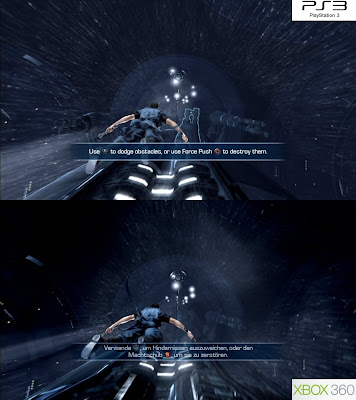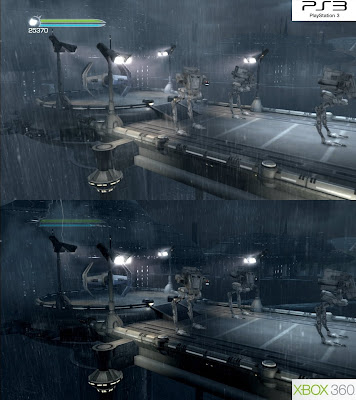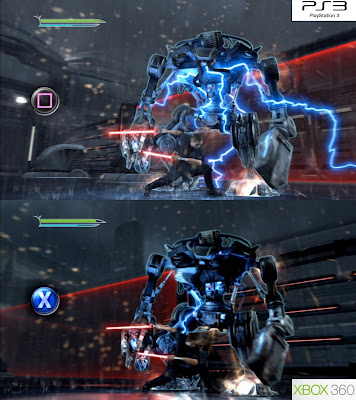The tech powering Burnout Paradise showed that one of the key factors in achieving parity across both formats was parallelisation; whereby off loading multiple tasks across multiple CPU threads and processors allowed for nearly every small bit of CPU/GPU time to be used effectively. Scalability was at the core, with the level of overall processing time constantly shifting accordingly between tasks that needed it as and when required.
Criterion understands that spreading the workload and keeping all parts of the rendering engine busy is the main factor in obtaining constantly high performance across the board, and on both platforms. But it’s more than that; optimising the engine so that the core components that make up the graphical look of the game are suited to both platforms, and not just one, plays an equally massive role too.
For Need For Speed: Hot Pursuit Criterion have done exactly that. Like with Burnout Paradise the team have been able to balance out the underlying tech behind the game, with an impressive feature set; including real-time image-based lighting on the cars, beautiful specular highlights, and large, open environments, with cross platform performance that is shockingly soild.


And performance is indeed the first thing that you’ll notice: NFS:HP is clocked at a constant 30fps with absolutely no screen tearing. It goes without saying that both formats are like for like in this regard, and if anything proves that Criterion’s engine delivers on what it set out to do.
The game almost never deviates from its initial 30fps update, only taking a quick drop during some of the more intensive takedown scenes, but never during normal racing/driving. The same thing is true for both PS3 and 360; even when driving around like a lunatic, crashing into scenery and smashing into the sides of your rivals, the game preserves its smoothness with ease.
Along with barely any slowdown, I have to say that it is definitely something of a surprise to see a distinct lack of screen tearing being present during gameplay. NFS:HP seems to continuously maintain v-sync on both PS3 and 360 without needing to drop it in order to preserve framerate. This in contrast to the likes of Split Second in which v-sync is temporarily disengaged in order to ensure more steady performance as a result. But here, there doesn’t seem to be a problem.
However, I must also state that it is incredibly hard to detect extremely minor events of screen tearing in such dark and low contrast areas, so maybe it is possible that the odd frame could be being torn on very brief occasions, though that is not obvious during regular gameplay. Without equipment to measure such things, I can only go by what I’m seeing.


Running at half the framerate of Burnout Paradise (that was 60fps) NFS feels distinctly different to Criterion’s last title, and not just because of the framerate. The handling model has been completely reworked and built up into what feels and looks like a new game, and not a simple re-hash of what has gone before. Though the use of a lower framerate, and this new, slower drifting mechanic has a dramatic effect on the action.
Obviously running at 30fps introduces higher controller latency into the mix, whereby button presses and turns of the analogue stick are ever so slightly less instant than if the game was running at a higher framerate. This latency is definitely apparent over and above the 60fps Burnout Paradise, although it is actually the new handling mechanics, and the use of demo specific cars that make the control seem to have a little more lag than it does.
In fact, when gently moving the left stick to turn you can see that small, almost instant movements are possible, and that it is the way the game plays that brings about this feeling – it is intentional, and reminiscent of the handling found in Black Rock’s Split Second.


So in terms of performance both versions appear pretty much like for like, and we can also see the same thing being applied to the rest of the demo. Looking at screens, and by playing both versions almost side-by-side (flicking back and forth between HDMI inputs) we can see that texture detail, filtering, lighting, and the vast majority of effects are exactly the same on both platforms. It’s basically a solid match, with next to no discernable differences.
However, there was one really small difference that I was able to spot, though you will really have to go looking for it. Some of the specular maps on the game’s road surfaces are rendered in a slightly higher resolution on the 360. You can see this in the screenshot below. Notice how the bump-mapping appears slightly clearer on the 360 build, and slightly more blurred on the PS3.
It’s a very minor observation, one which rears its head on only some surfaces. But to be fair this isn’t something you are ever likely to notice when playing the game. And even if you do, it certainly isn't something that intrudes on the overall experience.


Moving on to the general make up of the game and image quality analysis, and we can see that NFS:HP is rendered in 720p (1280x720) on both platforms, with the standard 2xMSAA (multi-sampling anti-aliasing) delivering ample edge smoothing.
Interestingly, there seems to be more than just MSAA going on in regards to this; many areas of the game (small pieces of geometry, objects in the distance, and most noticeably, power lines and thin wires) feature a surprising amount of jaggies reduction, more than what is possible with just regular MSAA. Both versions are exactly the same in this regard.
In the night-time police chase section – the only part of the demo we had access to – we can see that despite the low contrast nature of the scene aiding things slightly, that there is far less in the way of overall aliasing than expected on thin surfaces and polygon edges. Looking at still screen shots it is clear than parts of the environment are being smoothed out using another method of image smoothing. Which one, and how, we don’t really know, though the effect is solidly welcome.
However, the sub-pixel issue still appears in areas across the scene, with some objects in the distance still having noticeably shimmering edges, and some undesired shader aliasing. It’s definitely an improvement over what traditional anti-aliasing techniques would have provided, but not quite the clean, artifact free look that it can initially appear to be.
Either way, the use of MSAA plus additional edge smoothing is definitely beneficial, and delivers a tangible improvement over what we expected. It’s not anywhere near as impressive as God Of War 3’s use of MLAA (morphological anti-aliasing), but a nice inclusion nevertheless - many surfaces get great use of smoothing not otherwise obtainable by regular means.


Lastly, the way the lighting has been implemented is another nice plus point in this latest Criterion exploit. The whole game uses something called image-based lighting, whereby the cars are accurately lit by their surrounding environments at all times, meaning that the clouds and other numerous light sources all have an impact on how the cars look throughout the game.
This is done by rendering the environment first, using the more traditional forward rendering method, whilst the cars are done afterwards in a differed rendering pass. The environments have to be done first in order to accurately light and shade the cars; the result being a mightily impressive use of lighting with a level of realism not often seen outside high-end tech demos.


In the end the demo for Need For Speed: Hot Pursuit clearly showcases some of Criterion’s new tech rather nicely, and also manages to prove that their way of thinking when it comes to multi-platform development is in fact the right one. There’s barely any difference between the PS3 and 360 versions of the game, and aside from one small factor they look exactly the same.
The game may not always impressive on an artistic level – I personally don’t really like the night-time demo track all that much, but technically it definitely raises the bar in some respects. Some remaining sub-pixel aliasing isses aside (you need to use supersmapling, which isn’t feasible on consoles), it would be nice to see more developers taking this approach to game development.
Sadly, I wasn’t able to analyse the supposedly more impressive daytime track - it’s locked until one of your friends on both PSN and XBLA has downloaded and played the demo. And rather annoyingly, none of mine have, so a further look will be required when the final game comes out to really see just how well Criterion’s engine, and the overall game it self turns out. While the demo is a nice, intriguing starting point, it is only a tiny chunk of what the final release will have to offer.
As always thanks go out to AlStrong for the pixel counting, and Cynamite.de for most of our comparison screens. Mr Deap for the others. A full gallery can be found here.








































